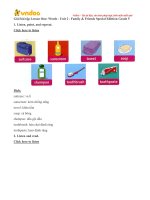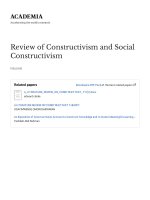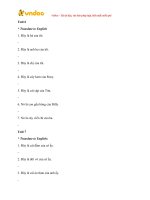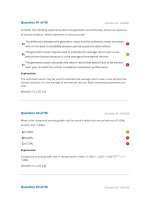Applied Structural and Mechanical Vibrations Theory
Bạn đang xem bản rút gọn của tài liệu. Xem và tải ngay bản đầy đủ của tài liệu tại đây (316.89 KB, 13 trang )
Applied Structural and
Mechanical Vibrations
Copyright © 2003 Taylor & Francis Group LLC
Applied Structural and
Mechanical Vibrations
Theory, methods and measuring
instrumentation
Paolo L.Gatti and Vittorio Ferrari
Copyright © 2003 Taylor & Francis Group LLC
First published 1999
by E & FN Spon
11 New Fetter Lane, London EC4P 4EE
Simultaneously published in the USA and Canada
by Routledge
29 West 35th Street, New York, NY 10001
This edition published in the Taylor & Francis e-Library, 2003.
E & FN Spon is an imprint of the Taylor & Francis Group
© 1999 Paolo L.Gatti and Vittorio Ferrari
All rights reserved. No part of this book may be reprinted or
reproduced or utilised in any form or by any electronic,
mechanical, or other means, now known or hereafter
invented, including photocopying and recording, or in any
information storage or retrieval system, without permission in
writing from the publishers.
The publisher makes no representation, express or implied, with
regard to the accuracy of the information contained in this book and
cannot accept any legal responsibility or liability for any errors or
omissions that may be made.
British Library Cataloguing in Publication Data
A catalogue record for this book is available from the British Library
Library of Congress Cataloging in Publication Data
Gatti, Paolo L., 1959–
Applied structural and mechanical vibrations: theory, methods,
and measuring instrumentation/Paolo L.Gatti and Vittorio Ferrari.
p. cm.
Includes bibliographical reference and index.
1. Structural dynamics. 2. Vibration. 3. Vibration—Measurement.
I. Ferrari, Vittorio, 1962– . II. Title.
TA654.G34 1999
620.3–dc21
98–53028
CIP
ISBN 0-203-01455-3 Master e-book ISBN
ISBN 0-203-13764-7 (Adobe eReader Format)
ISBN 0-419-22710-5 (Print Edition)
Copyright © 2003 Taylor & Francis Group LLC
To my wife Doria, for her patience and
understanding, my parents Paolina and Remo,
and to my grandmother Maria Margherita
(Paolo L.Gatti)
To my wife and parents
(V.Ferrari)
Copyright © 2003 Taylor & Francis Group LLC
Contents
Preface
Acknowledgements
PART I
Theory and methods
P.L.GAT T I
1 Review of some fundamentals
1.1
1.2
1.3
1.4
1.5
Introduction
The role of modelling (linear and nonlinear, discrete
and continuous systems, deterministic and random data)
Some definitions and methods
Springs, dampers and masses
Summary and comments
2 Mathematical preliminaries
2.1
2.2
2.3
2.4
2.5
Introduction
Fourier series and Fourier transforms
Laplace transforms
The Dirac delta function and related topics
The notion of Hilbert space
References
3 Analytical dynamics—an overview
3.1
3.2
3.3
3.4
Introduction
Systems of material particles
Generalized coordinates, virtual work and d’Alembert principles:
Lagrange’s equations
Hamilton’s principle of least action
Copyright © 2003 Taylor & Francis Group LLC
3.5
3.6
The general problem of small oscillations
Lagrangian formulation for continuous systems
References
4 Single-degree-of-freedom systems
4.1
4.2
4.3
4.4
4.5
Introduction
The harmonic oscillator I: free vibrations
The harmonic oscillator II: forced vibrations
Damping in real systems, equivalent viscous damping
Summary and comments
References
5 More SDOF—transient response and approximate methods
5.1
5.2
5.3
5.4
5.5
5.6
Introduction
Time domain—impulse response, step response and convolution
integral
Frequency and s-domains. Fourier and Laplace transforms
Relationship between time-domain response and
frequency-domain response
Distributed parameters: generalized SDOF systems
Summary and comments
References
6 Multiple-degree-of-freedom systems
6.1
6.2
6.3
6.4
6.5
6.6
6.7
6.8
6.9
Introduction
A simple undamped 2-DOF system: free vibration
Undamped n-DOF systems: free vibration
Eigenvalues and eigenvectors: sensitivity analysis
Structure and properties of matrices M, K and C: a few
considerations
Unrestrained systems: rigid-body modes
Damped systems: proportional and nonproportional
damping
Generalized and complex eigenvalue problems: reduction to
standard form
Summary and comments
References
7 More MDOF systems—forced vibrations and response analysis
7.1
Introduction
Copyright © 2003 Taylor & Francis Group LLC
7.2
7.3
7.4
7.5
7.6
7.7
7.8
Mode superposition
Harmonic excitation: proportional viscous damping
Time-domain and frequency-domain response
Systems with rigid-body modes
The case of nonproportional viscous damping
MDOF systems with hysteretic damping
A few remarks on other solution strategies: Laplace transform
and direct integration
7.9 Frequency response functions of a 2-DOF system
7.10 Summary and comments
References
8 Continuous or distributed parameter systems
8.1
8.2
8.3
Introduction
The flexible string in transverse motion
Free vibrations of a finite string: standing waves and
normal modes
8.4 Axial and torsional vibrations of rods
8.5 Flexural (bending) vibrations of beams
8.6 A two-dimensional continuous system: the flexible membrane
8.7 The differential eigenvalue problem
8.8 Bending vibrations of thin plates
8.9 Forced vibrations and response analysis: the
modal approach
8.10 Final remarks: alternative forms of FRFs and the introduction
of damping
8.11 Summary and comments
References
9 MDOF and continuous systems: approximate methods
9.1
9.2
9.3
9.4
Introduction
The Rayleigh quotient
The Rayleigh-Ritz method and the assumed modes method
Summary and comments
References
10 Experimental modal analysis
10.1 Introduction
10.2 Experimental modal analysis—overview of the
fundamentals
Copyright © 2003 Taylor & Francis Group LLC
10.3 Modal testing procedures
10.4 Selected topics in experimental modal analysis
10.5 Summary and comments
References
11 Probability and statistics: preliminaries to random vibrations
11.1 Introduction
11.2 The concept of probability
11.3 Random variables, probability distribution functions and
probability density functions
11.4 Descriptors of random variable behaviour
11.5 More than one random variable
11.6 Some useful results: Chebyshev’s inequality and the central limit
theorem
11.7 A few final remarks
References
12 Stochastic processes and random vibrations
12.1
12.2
12.3
12.4
12.5
Introduction
The concept of stochastic process
Spectral representation of random processes
Random excitation and response of linear systems
MDOF and continuous systems: response to random
excitation
12.6 Analysis of narrow-band processes: a few selected topics
12.7 Summary and comments
References
Further reading to Part I
PART II
Measuring instrumentation
V.FERRARI
13 Basic concepts of measurement and measuring instruments
13.1
13.2
13.3
13.4
Introduction
The measurement process and the measuring instrument
Measurement errors and uncertainty
Measuring instrument functional model
Copyright © 2003 Taylor & Francis Group LLC
13.5
13.6
13.7
13.8
13.9
Static behaviour of measuring instruments
Dynamic behaviour of measuring instruments
Loading effect
Performance specifications of measuring instruments
Summary
References
14 Motion and vibration transducers
14.1 Introduction
14.2 Relative- and absolute-motion measurement
14.3 Contact and noncontact transducers
14.4 Relative-displacement measurement
14.5 Relative-velocity measurement
14.6 Relative-acceleration measurement
14.7 Absolute-motion measurement
14.8 Accelerometer types and technologies
14.9 Accelerometer choice, calibration and mounting
14.10 General considerations about motion measurements
14.11 Force transducers
14.12 Summary
References
15 Signal conditioning and data acquisition
15.1
15.2
15.3
15.4
15.5
15.6
15.7
15.8
Introduction
Signals and noise
Signal DC and AC amplification
Piezoelectric transducer amplifiers
Noise and interference reduction
Analogue-to-digital conversion
Data acquisition systems and analysis instruments
Summary
References
Further reading to Part II
Appendices
P.L.GAT T I
A
Finite-dimensional vector spaces and elements of matrix analysis
A.1
The notion of finite-dimensional vector space
Copyright © 2003 Taylor & Francis Group LLC
A.2
A.3
A.4
B
Matrices
Eigenvalues and eigenvectors: the standard eigenvalue
problem
Matrices and linear operators
References
Further reading
Some considerations on the assessment of vibration intensity
B.1
B.2
Introduction
Definitions
References
Further reading
Copyright © 2003 Taylor & Francis Group LLC
Preface
This book deals primarily with fundamental aspects of engineering vibrations
within the framework of the linear theory. Although it is true that in practical
cases it is sometimes not easy to distinguish between linear and nonlinear
phenomena, the basic assumption throughout this text is that the principle
of superposition holds.
Without claim of completeness, the authors’ intention has been to discuss
a number of important topics of the subject matter by bringing together, in
book form, a central set of ideas, concepts and methods which form the
common background of real-world applications in disciplines such as
structural dynamics, mechanical, aerospace, automotive and civil engineering,
to name a few.
In all, the authors claim no originality for the material presented. However,
we feel that a book such as this one can be published at the end of the 1990s
because, while it is true that the general theory of linear vibrations is well
established (Lord Rayleigh’s book Theory of Sound is about a century old),
this by no means implies that the subject is ‘closed’ and outside the mainstream
of ongoing research. In fact, on the one hand, the general approach to the
subject has significantly changed in the last 30 years or so. On the other
hand, the increasing complexity of practical problems puts ever higher
demands on the professional vibration engineer who, in turn, should acquire
a good knowledge in a number of disciplines which are often perceived as
distinct and separate fields.
Also, in this regard, it should be considered that the computer revolution
of recent years, together with the development of sophisticated algorithms
and fully automated testing systems, provide the analyst with computation
capabilities that were unimaginable only a few decades ago. This state of
affairs, however—despite the obvious advantages—may simply lead to
confusion and/or erroneous results if the phenomena under study and the
basic assumptions of the analysis procedures are not clearly understood.
The book is divided into two parts. Part I (Chapters 1 to 12) has been
written by Paolo L.Gatti and is concerned with the theory and methods of
linear engineering vibrations, presenting the topics in order of increasing
difficultly—from single-degree-of-freedom systems to random vibrations and
Copyright © 2003 Taylor & Francis Group LLC
stochastic processes—and also including a number of worked examples in
every chapter. Within this part, the first three chapters consider, respectively,
some basic definitions and concepts to be used throughout the book (Chapter
1), a number of important aspects of mathematical nature (Chapter 2) and
a concise treatment of analytical mechanics (Chapter 3). In a first reading,
if the reader is already at ease with Fourier series, Fourier and Laplace
transforms, Chapter 2 can be skipped without loss of continuity. However,
it is assumed that the reader is familiar with fundamental university calculus,
matrix analysis (although Appendix A is dedicated to this topic) and with
some basic notions of probability and statistics.
Part II (Chapters 13 to 15) has been written by Vittorio Ferrari and deals
with the measurement of vibrations by means of modern electronic
instrumentation. The reason why this practical aspect of the subject has been
included as a complement to Part I lies in the importance—which is sometimes
overlooked—of performing valid measurements as a fundamental requirement
for any further analysis. Ultimately, any method of analysis, no matter how
sophisticated, is limited by the quality of the raw measurement data at its
input, and there is no way to fix a set of poor measurements. The quality of
measurement data, in turn, depends to a large extent on how properly the
available instrumentation is used to set up a measuring chain in which each
significant source of error is recognized and minimized. This is especially
important in the professional world where, due to a number of reasons such
as limited budgets, strict deadlines in the presentation of results and/or real
operating difficulties, the experimenter is seldom given a second chance.
The choice of the topics covered in Part II and the approach used in the
exposition reflect the author’s intention of focusing the attention on basic
concepts and principles, rather than presenting a set of notions or getting
too much involved in inessential technological details. The aim and hope is,
first, to help the reader—who is only assumed to have a knowledge of basic
electronics—in developing an understanding of the essential aspects related
to the measurement of vibrations, from the proper choice of transducers and
instruments to their correct use, and, second, to provide the experimenter
with guidelines and advice on how to accomplish the measurement task.
Finally, it is possible that this book, despite the attention paid to reviewing
all the material, will contain errors, omissions, oversights and/or misprints.
We will be grateful to readers who spot any of the above or who have any
comment for improving the book. Any suggestion will be received and
considered.
Milan 1998
Paolo Luciano Gatti,
Vittorio Ferrari
Email addresses:
Copyright © 2003 Taylor & Francis Group LLC
Acknowledgements
I wish to thank Dr G.Brunetti at Tecniter s.r.l. (Cassina de’ Pecchi, Milan)
for allowing me to take some time off work and complete the manuscript
(almost) on time, Eng. R.Giacchetti at the University of Ancona for
introducing me (a nuclear physicist) to the fascinating subject of engineering
vibrations, and my long time friend and electronics expert Dr V.Ferrari for
his important contribution to this project. Last but not least, I wish to thank
Professor Valz-Gris (Department of Physics, State University of Milan) for
valuable mathematical advice.
Paolo L.Gatti
I would like to thank Professor A.Taroni and Professor D.Marioli at the
University of Brescia for their encouragement whilst I was writing this book.
Vittorio Ferrari
Both authors wish to thank everybody at Routledge (London) for their
cooperation, competence and efficiency.
Copyright © 2003 Taylor & Francis Group LLC




